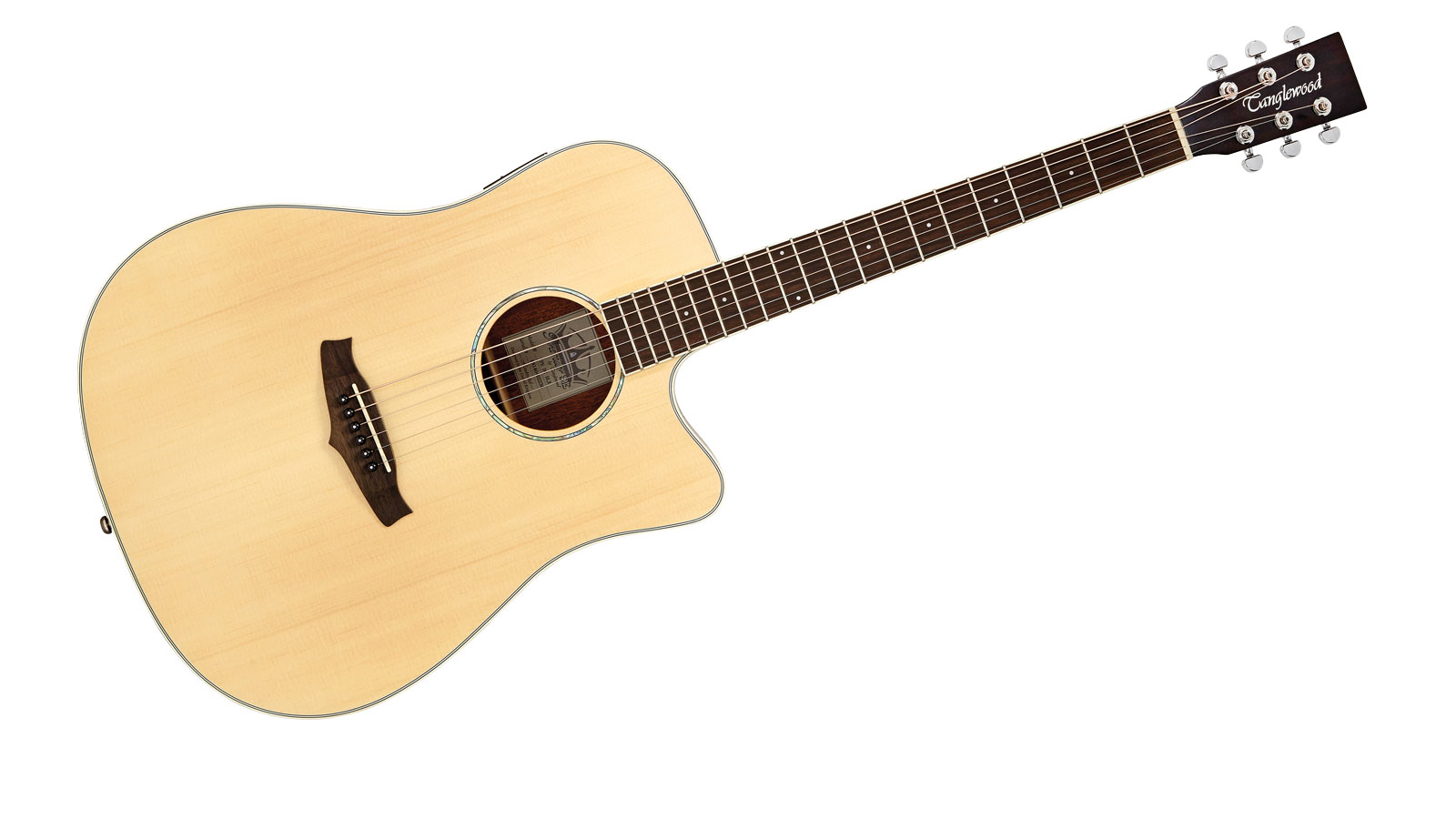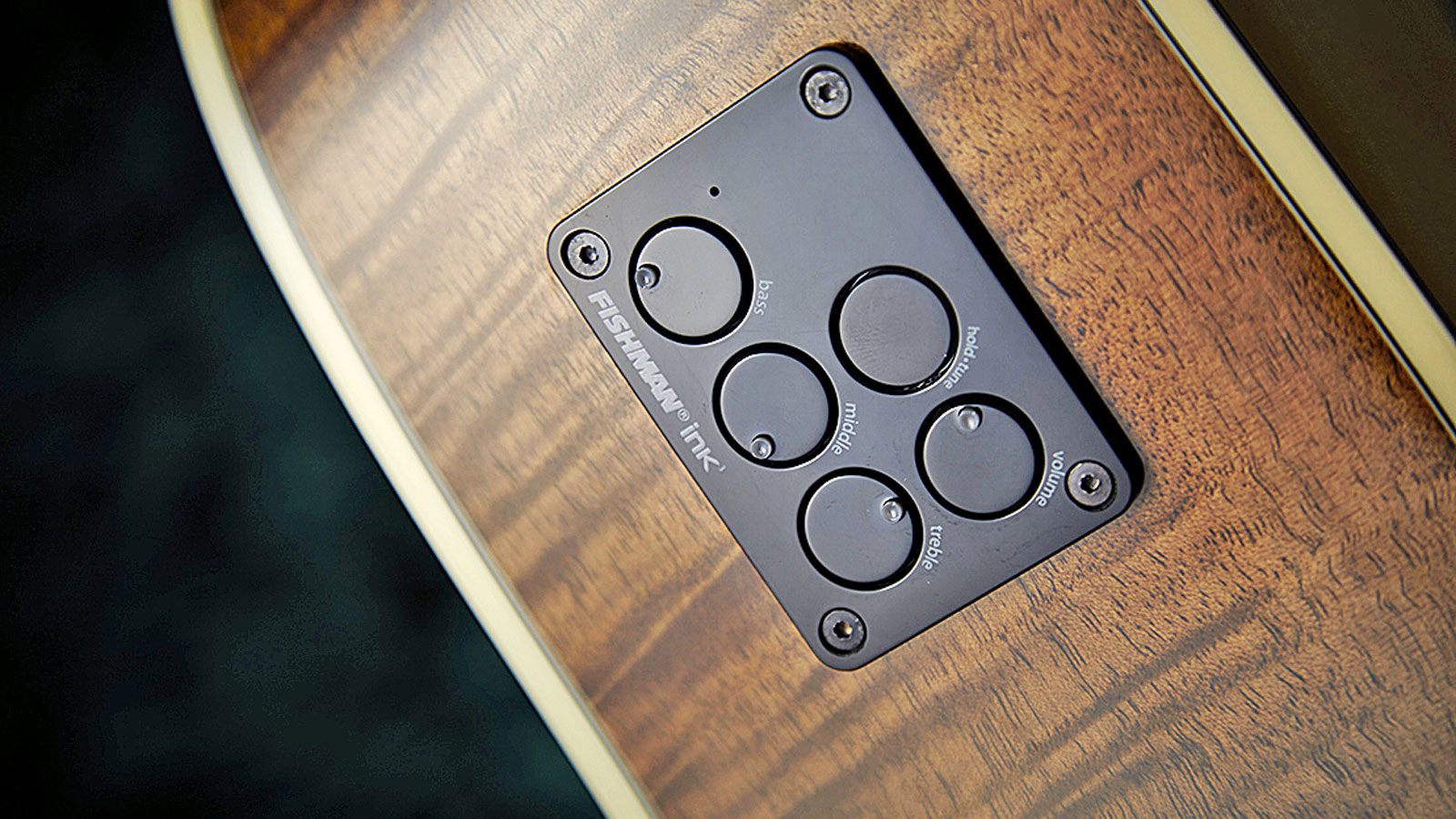MusicRadar Verdict
A classically styled dreadnought cutaway with great build quality, value for money, playability and sound.
Pros
- +
Fishman preamp works well. Nice neck. Ideal for rhythm work, or alternative modern tunings.
Cons
- -
Rosette is slightly incongruous.
MusicRadar's got your back

Tanglewood Premier Deluxe TPE DC DLX

Preamp

Headstock
This year, Tanglewood tidied up its thicket of ranges to make space for a fresh bloom of new guitars such as the Premier SEs, or 'satin exotic'. The exotic wood theme continues with this brand-new, all-gloss finished Premier Deluxe TPE SF DLX that features laminate tiger mahogany back and side. Yup, that's a new one on us too.
Designed in the UK, with notable input from Scandinavian master luthier Michael Sanden, but made in the Far East, Tanglewood has been steadily building a reputation for good value with a thoughtful, even progressive, approach to design. The TPE SF DLX certainly looks like it will fuel that fire.
"It has a reassuringly high-class, high-ticket appearance"
It's the outer facings of the three-ply back and sides that feature the figured mahogany veneer, which certainly has an unusual hue: the ripples in the grain fade through gold to brown and even to green at certain angles. Rather classy.
Trimmed in super-neat off-white plastic binding with a subtle pinstripe black purfling, it has a reassuringly high-class, high-ticket appearance. Shape-wise, with its unfussy headstock and chunky, slightly waisted body, is the spitting image of a modern Martin, although the abalone rosette and folksy bridge are slightly incongruous here.
There is, however, a vibrant-looking solid Englemann spruce top, too - it couldn't look sharper if it wore an Ozwald Boateng suit.
Under the hood, there have been other changes. "I have designed a new bracing pattern for Tanglewood," explains Sanden, "which will be used for most of their guitars in the future.
"When you have to trust big factories to make the guitars, scalloped bracing, which is very popular, can be really unsafe. We wanted a stable top, and when you make guitars in larger production numbers the tightness of the [top's] grain can vary quite a bit, which in turn can affect the stiffness.
Want all the hottest music and gear news, reviews, deals, features and more, direct to your inbox? Sign up here.
"So, the bracing we now use is what we call a tapered one. That means that the brace does not have the scooped-out scalloped areas, but tapers towards the end evenly. This, together with a couple of other things, helps the uniformity of all the guitars and is the most important thing we have changed, with, of course, variations for smaller or bigger models."
This Premier Deluxe model also introduces the Fishman INK 3 preamp, an unfussy new system that includes a Sonicore under-saddle pickup - with a neat panel of flush rotary controls within a small footprint panel on the upper shoulder.
It also features a very tidy combination of strap button, jack socket and battery holder at the base, rather than the more common combined strap button and output jack with a separate battery compartment.
Feel & Sounds
The neck profile is very mainstream and has a very subtle V to the overall rounded, deep C profile. It's certainly a comfortable all-purpose shape and excellent for 'thumb around' left-hand styles.
"Full-blooded rhythm work is always the stamp of a good dreadnought, and this Tanglewood can do it all day"
There's also a volute behind the nut, which adds strength at the thinnest point of the neck, and we like the way that this traditional feature has been deftly executed here.
The tidily fretted rosewood 'board is slightly less cambered than any of our regular workhorse, but this sits well with the action, which is low enough to play easily but can still take some picking without untoward fret buzz.
The tuners are perfectly fit for purpose, responding totally predictably when retuning or detuning, and overall intonation seems spot on, too, in standard and altered tunings or with a capo high up the fingerboard.
When it comes to the acoustic sounds, it's both pushy with lots of presence and has a clear, contemporary tonality with satisfying strength, balance and a smooth sustain tail. With a medium-heavy pick there's a pleasing high-mid click to the front end of the notes when strummed - good for more percussive styles.
Full-blooded rhythm work down in first position is always the stamp of a good dreadnought, and this Tanglewood can do it all day, albeit with a slightly tight low end, certainly in comparison with our reference (and more expensive, of course!) Martin DC-16. Detune to D, or even C, and the bottom end warms up considerably; hopefully, with playing, it'll open up some more.
The Fishman preamp features volume, bass, middle and treble controls, and a chromatic tuner. The system comes with an instruction booklet that, for once in our lives, we looked at. It offers some simple suggestions for strummers and fingerstyle pickers in terms of EQ settings, and if you're new to the world of amplified acoustics it's well worth experimenting.
It took very little time to feel comfortable with the variety and versatility that the EQ offers, and it shouldn't prove a challenge for the novice or even the most technophobic player. And there's no straining to hear the subtle nuances either: turn up the bass, for example, and you know that's exactly what you've got.
Sonically, in no way is this guitar an introvert - amplified or acoustically. The bold, crisp tones make it ideal for playing in a group situation as well as contemporary altered tuning fingerstyle. If you're planning to take to the stage anytime soon and need an affordable, ready-to-go electro, you should check this out.